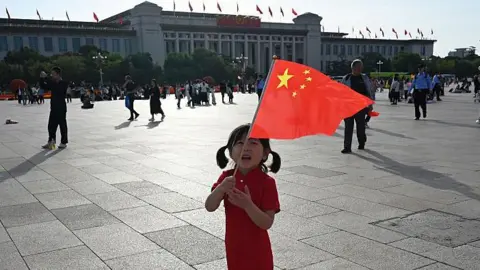China's Five Year Plan: Shaping Global Economies and Future Visions
 AFP via Getty Images
AFP via Getty ImagesChina's top leaders are gathering in Beijing this week to decide on the country's key goals and aspirations for the rest of the decade.
Every year or so, the country's highest political body, the Central Committee of the Chinese Communist Party, convenes for a week of meetings, also known as a Plenum.
What it decides at this one will eventually form the basis of China's next Five Year Plan - the blueprint that the world's second largest economy will follow between 2026 and 2030.
The full plan won't come until next year, but officials are likely to hint at its contents on Wednesday and have previously given more details within a week of that.
Western policy works on election cycles, but Chinese policy making operates on planning cycles, says Neil Thomas, a fellow in Chinese politics at the Asia Society Policy Institute.
Five Year Plans spell out what China wants to achieve, signal the direction the leadership wants to go in and move the resources of the state towards these predefined conclusions, he adds.
On the surface, the idea of hundreds of suited bureaucrats shaking hands and drawing up plans may appear drab - but history tells us that what they decide often has huge repercussions for the world.
Here are three times China's Five Year Plans reshaped the global economy:
1981-84: Reform and Opening Up
Pinpointing exactly when China began its journey to become an economic powerhouse is difficult, but many in the Party like to say it was on 18 December 1978.
For nearly three decades, China's economy had been rigidly controlled by the state. But Soviet-style central planning had failed to lift prosperity and many were still struggling in poverty.
The country was still recovering from Mao Zedong's disastrous rule which led to millions of deaths.
Speaking at the 11th Committee's Third Plenary in Beijing, the country's new leader Deng Xiaoping declared that it was time to embrace some elements of the free market.
His policy of reform and opening up became integral to the next Five Year Plan, which began in 1981.
The creation of free trading Special Economic Zones - and the foreign investment they attracted - transformed the lives of people in China.
2011-15: Strategic Emerging Industries
China's status as the workshop of the world was cemented once it joined the World Trade Organization in 2001. But at the turn of the century, the Communist Party leadership was already planning its next move to avoid falling into the so-called middle income trap.
So instead of just cheap manufacturing, China needed to discover its strategic emerging industries - focusing on green technology such as electric vehicles and solar panels.
2021-2025: High Quality Development
China's Five Year Plans have shifted focus toward high quality development, with aims to challenge American dominance in technology and highlight national self-reliance in innovation.
The need for self-sufficiency in critical technologies such as semiconductors, computing, and AI is becoming increasingly clear as the nation navigates geopolitical hurdles.





















